The US Federal Reserve faces a tough call today
Whatever the Fed says will send shock waves through the market. John C Burford uses the charts to size up the possible effects.
This could be one of the most important days of the year for the markets. At 7pm UK time, the Fed is expected to say something significant regarding their intentions for their QE (quantitative easing) scheme. There is no shortage of predictions out there, but one thing is clear - decisions must be made soon.
There is little doubt that QE has had a big impact on asset markets. US equities have rallied, while the real economy has languished. GDP growth and employment are the weakest of any post-recession recovery in recent history.
That has left the Fed with the following dilemma: should they continue (or increase) QE to get the economy and employment growing satisfactorily (and keep the asset bubble alive)? Or should they risk an adverse market reaction by gradually reducing (tapering') the scheme?
MoneyWeek
Subscribe to MoneyWeek today and get your first six magazine issues absolutely FREE

Sign up to Money Morning
Don't miss the latest investment and personal finances news, market analysis, plus money-saving tips with our free twice-daily newsletter
Don't miss the latest investment and personal finances news, market analysis, plus money-saving tips with our free twice-daily newsletter
We all remember the 22 May fiasco when they hinted at a tapering. The markets dropped sharply, and that is still fresh in their (and our) minds. But further asset price inflation risks an even bigger collapse later on. Basically, they are damned if they do and damned if they don't.
A grave warning for bulls
The extreme bullishness of investors in the stock market is in sharp contrast to US consumer mood. I'm referring to the Bloomberg Consumer Comfort Index, which is a monthly poll of the views of the public on the condition of the US economy, their personal finances and their purchasing climate. In effect, it is a proxy for the degree of bullish or bearish mood among the public.
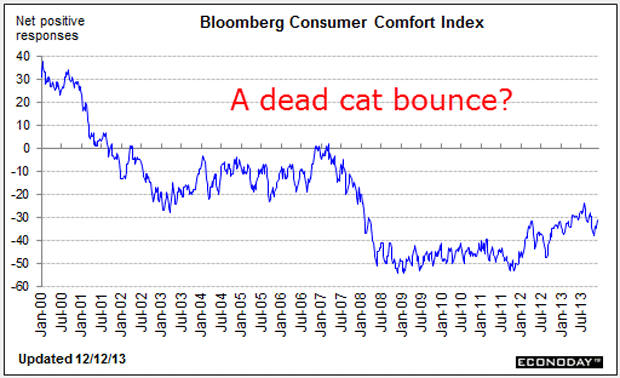
The 2008 credit crunch sent the mood into very dark territory. The readings were at minus 50. That was not an unexpected outcome. And in the five years since, it has only edged up to minus 30. Compared with the pre-2000 positive readings, this recovery' appears very weak indeed and I call that a 'dead cat bounce'.
All divergences are eventually corrected
So what will it take to get the index up into positive territory where the public feel good about their situation? Is it more QE?
It is clear the QE programme has created a big divide between Wall Street and Main Street (and not for the first time). This is one reason why I am looking for a top in stock markets.
On Friday, I had this chart of the Dow:
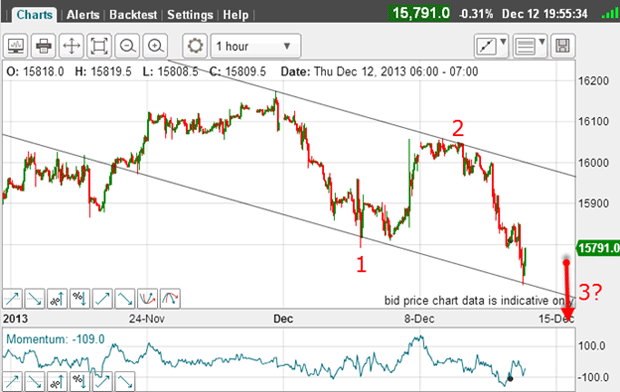
I had my tentative Elliott wave labels and my tramline pair, with the market last week touching my lower tramline. The bounce off it set up the alternative interpretation that the wave pattern is an A-B-C, leading to new highs.
But on Monday this became a less likely alternative. That was when the market made a new low, touched my tramline again and thereby put in my fifth wave:
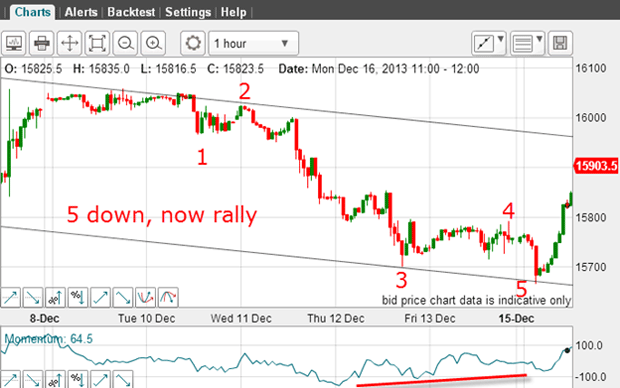
With this five-wave pattern complete, the market had only one way to go up. That was therefore an excellent place to take profits on short trades.
In fact, Monday's rally was vigorous and carried mightily towards my upper tramline. And yesterday, the market consolidated at these elevated levels.
What will happen after the Fed announcement?
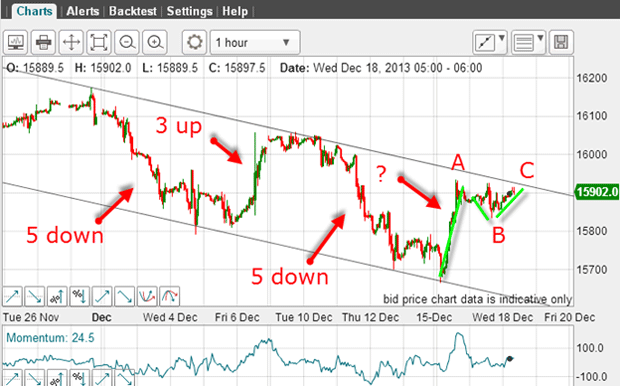
From the 29 November high, I have a five down (see previous emails) and then a 3 up and then a five down. The question is: will we see another 3 up? If so, the odds of a new bear trend increase greatly.
I have my A and B waves, and this morning a budding C wave is in progress. And as I write, it is just about hitting my upper tramline resistance.
This sets up an intriguing possibility: the market could rally above the tramline after the Fed announcement this evening, If it does that, then the other question is: will the gains hold, or will it be met with heavy selling to push the market back under my tramline? If the market does that, it is sending a bearish signal. That would be a case of buying the rumour and selling the news'.
And recent history supports this outcome. Here is a chart of the S&P with Fed QE news events marked:
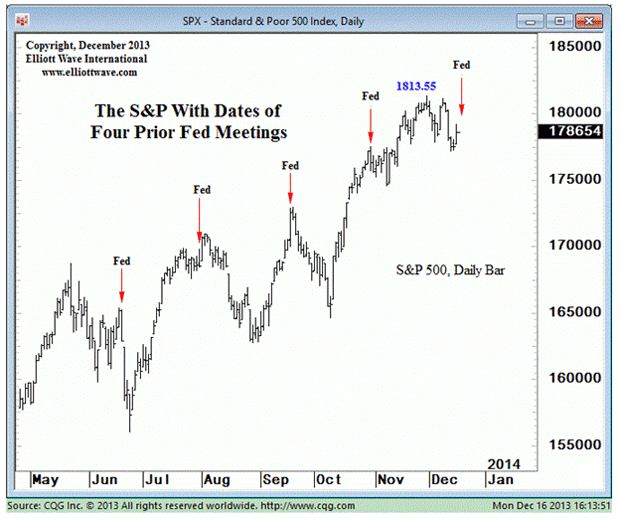
(Chart courtesy ofelliottwave.com)
For the past four months, the market has made a high on or very close to the Fed dates. Will history repeat and produce a fifth today?
Get the latest financial news, insights and expert analysis from our award-winning MoneyWeek team, to help you understand what really matters when it comes to your finances.
John is is a British-born lapsed PhD physicist, who previously worked for Nasa on the Mars exploration team. He is a former commodity trading advisor with the US Commodities Futures Trading Commission, and worked in a boutique futures house in California in the 1980s.
He was a partner in one of the first futures newsletter advisory services, based in Washington DC, specialising in pork bellies and currencies. John is primarily a chart-reading trader, having cut his trading teeth in the days before PCs.
As well as his work in the financial world, he has launched, run and sold several 'real' businesses producing 'real' products.
-
 Investors will reap long-term rewards from UK equities
Investors will reap long-term rewards from UK equitiesOpinion Nick Train, portfolio manager, Finsbury Growth & Income Trust, highlights three UK equities where he’d put his money
-
 The graphene revolution is progressing slowly but surely
The graphene revolution is progressing slowly but surelyEnthusiasts thought the discovery that graphene, a form of carbon, could be extracted from graphite would change the world. They might've been early, not wrong.